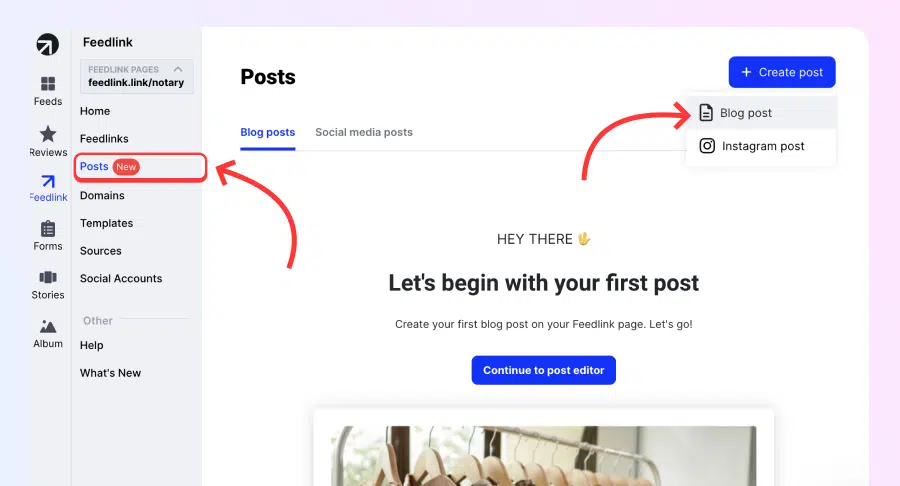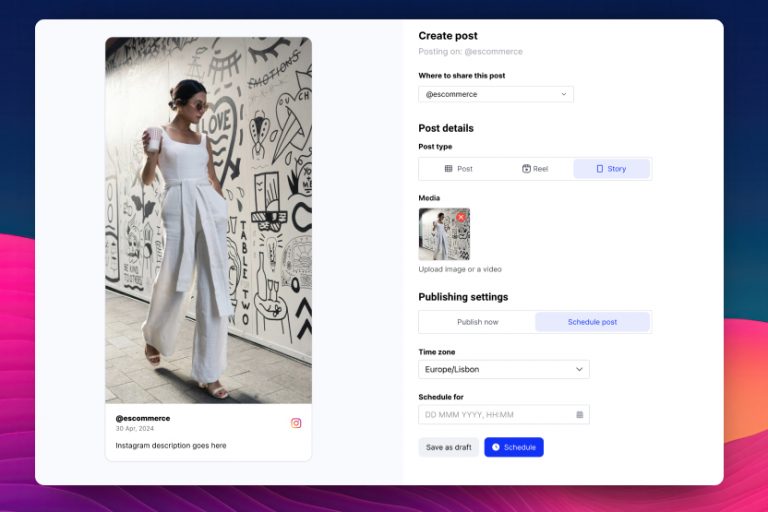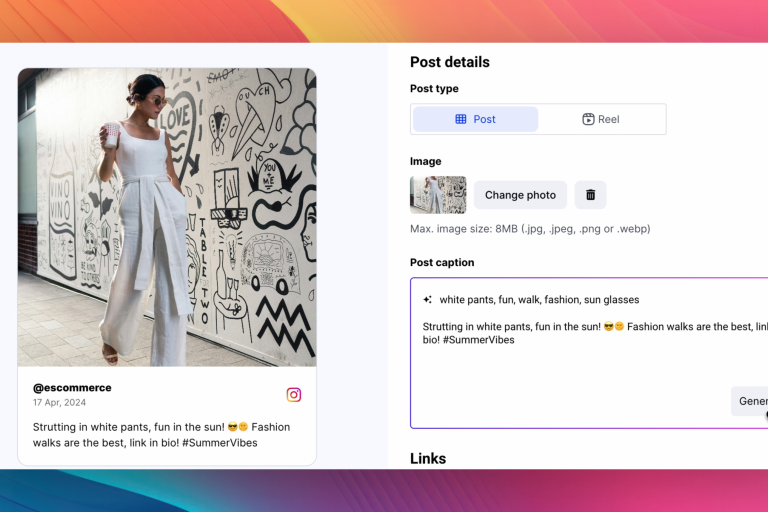The question now is not if but how to create a blog that will grow your small business.
Blogs are not just for newsletter writers or professional bloggers. They are for everyone who wants to share more detailed stories and can be a perfect medium for small business owners to engage with a wider audience.
Although social media platforms are currently the main publishing venue for small businesses, blogs still offer a more durable and long-lasting platform for content. This is particularly important for small businesses, as blogs provide a unique opportunity to delve deeper into their brand story, showcase their expertise, and build a more substantial online presence.
Continue reading to learn how to start a small business blog today.
Why start your own blog for your small business?
If you ever thought you wouldn’t need a blog when starting your business, you must have soon realized you were wrong. Blogs are an inexpensive yet effective solution to boosting your brand reach. Plus, they come with tons of benefits, such as:
- Enhanced visibility – blogs improve your online presence, making it easier for potential customers to find you through search engines;
- Establishing authority – regularly posting informative and relevant content positions your business as an industry expert;
- Direct communication channel – a blog allows for direct interaction with your audience, fostering stronger customer relationships;
- Cost-effective marketing – blogging is a highly effective yet low-cost way to market your products or services;
- Increased engagement – engaging content can drive more traffic to your website, keeping visitors interested and returning for more;
- SEO advantages – regularly updated blogs contribute to better search engine optimization (SEO), helping your site rank higher in search results;
- Content for social media – blog posts provide valuable content that can be shared across social media platforms, expanding your reach;
- Long-term results – well-crafted blog posts can continue to attract new customers long after they are published;
- Feedback & insights – comments and interactions on your blog can provide valuable feedback and insights into your customer’s needs and preferences;
- Personal touch – a blog allows you to show the human side of your business, building trust and authenticity with your audience.
As a summary, here is a comparison table of why starting a blog is a good idea v.s solely publishing on social media.
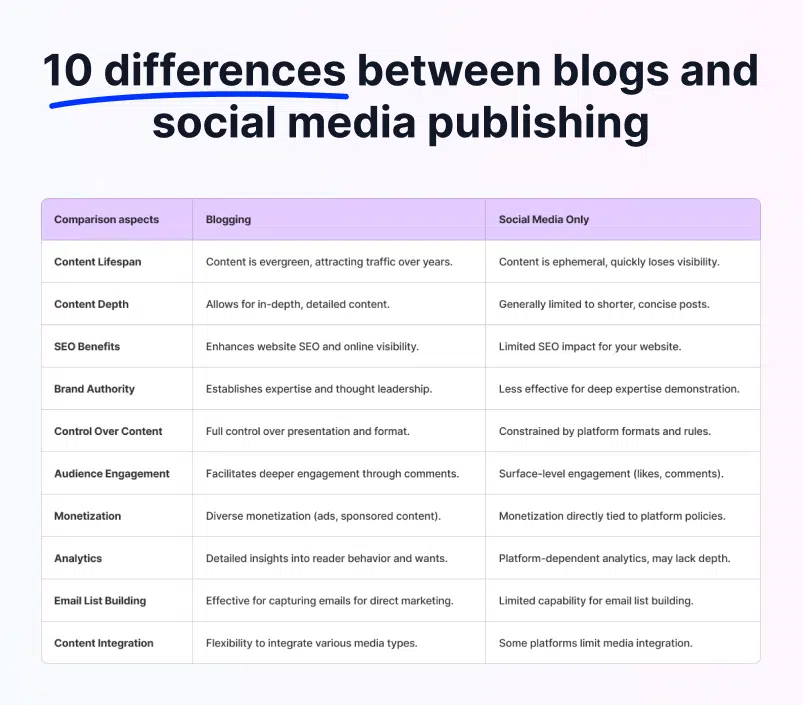
As you can see, blogging is not just trendy; it’s a strategy necessity that helps your business in so many different ways. Remember, beyond the tangible SEO and social media advantages, a blog also adds a personal touch to your brand, thus building trust with your audience.
Starting a small business blog: Step-by-step guide
- Choose your blogging platform
- Pick a domain name describing your business niche
- Design your blog layout
- Brainstorm blog post ideas and create topic clusters
- Write and edit your compelling blog posts
- Use good SEO practices and publish your first blog post
- Create an editorial calendar and promote your blog
If you want your blog to stand out as an invaluable asset for your customers, you must diligently complete all of the following steps. That way, you’ll provide a unique platform that shares expertise, engages with customers, and amplifies your brand’s voice.
Step 1: Choose your blogging platform
Before diving headfirst into blogging, you need to prepare your digital canvas. Toward that goal, you have to decide on the right platforms for content management (CMS) and website hosting. Making the right pick at this point is crucial for a successful and thriving blog.
Blogging platform (CMS)
Think of a CMS as your creative playground where you build and mold your blogging content. Depending on whether your blogging platform comes with a hosting option, it’ll either be a self-hosted CMS or a hosted CMS platform. These are the differences:
a) Self-hosted platforms:
These help you unleash your creative potential by giving you complete control, flexibility, and customization that comes via a plugin store:
- For the tech-savvy—offers ultimate customizability but requires technical knowledge;
- Drawbacks—require a separate hosting plan, which can be daunting for beginners;
- Examples—WordPress.org (most popular), Drupal, Ghost, etc.
b) Hosted platforms:
These focus on providing you with a beginner-friendly all-in-one solution:
- Ideal for beginners—simplify setup and management, often with hosting included;
- Drawbacks—offer less customization and control compared to self-hosted options;
- Examples—Wix, Squarespace, Blogger, etc.
Hosting provider
Hosting providers store your blog (or any other website) on remote servers under a unique address so your customers can find and access it.
If you opt for the self-hosted route, you need to subscribe to a hosting provider with strong uptime, robust security features, and excellent access speeds.
Popular options include Hostinger, Bluehost, SiteGround, etc.
Choosing the right combo
The ideal platform and hosting provider depend on various factors, including your technical expertise, budget, and specific needs. For instance, if you are confident with technology, go for a self-hosted WordPress blog platform and a hosting provider of your choosing.
However, if you are just starting, hosted platforms provide a user-friendly experience with minimal technical setup. On top of that, they often include free and/or cheaper plans compared to self-hosted platforms and a separate hosting provider combo.
Whatever you choose, remember to pick a platform that also includes additional features to help reach your goals faster, such as SEO tools and social media integration.
Try Feedlink: The ultimate solution for your blogging needs
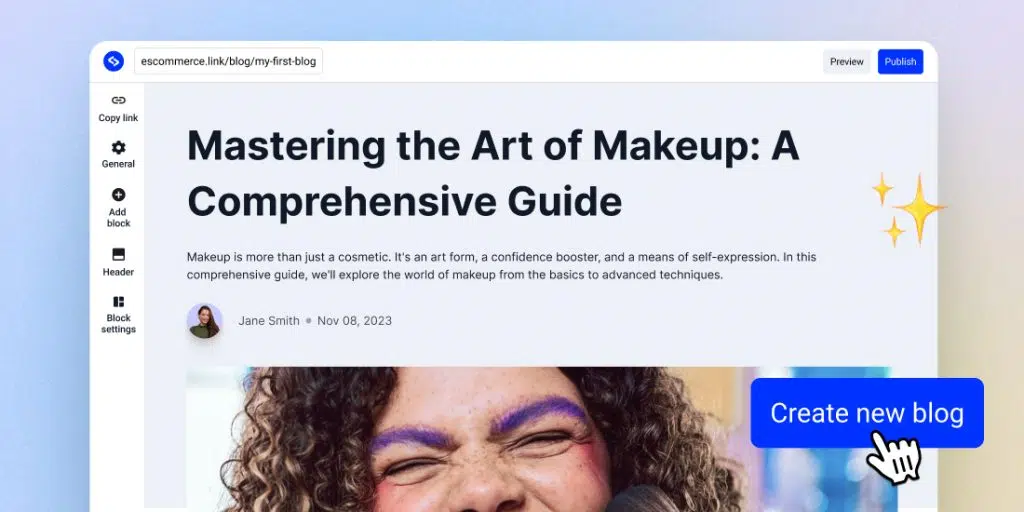
Instead of looking at different services to cover your blog hosting and design needs, search for an all-around product that does everything in one single platform.
Feedlink is an all-in-one website for small business owners!
In addition to providing you with everything you need to create the perfect compact website with a custom .link domain, Feedlink offers social media post scheduling, automated newsletter features, and, best of all, the option to start and run your own blog on Feedlink.
Write and design longer blog posts and publish and maintain them under your own blog domain. You’ll rarely get it as good and as easy anywhere else! Plus, you can have your new blog post automatically appear on your main Feedlink site as soon as it goes live!
Free blogging tool
Start a free blog
Step 2: Pick a domain name describing your business niche
Since your potential customers and visitors will immediately make an impression about your business from your domain name, you must carefully choose one that accurately reflects your business niche. Additionally, there are several other considerations:
- Branding – a strong domain blog name reinforces your brand identity and helps you stand out among other similar businesses;
- SEO ranking – search engines consider domain names in their ranking algorithms, and relevant names improve your SEO and increase website traffic;
- User experience – a clear and memorable domain name is easier for users to remember and type, leading to a better user experience;
- Professionalism – a domain blog name with a recognized and professional extension (e.g., .com, .net, .org) portrays a more trustworthy image.
Tips to pick a domain name
Here are some tips for picking the right domain name:
- Keep it short and memorable – aim for a domain blog name that is easy to spell and pronounce;
- Use relevant keywords -include keywords that describe your business blog niche;
- Make it unique and brandable – avoid using generic domain names that are already taken or difficult to differentiate;
- Consider extensions – popular extensions like .com, .net, and .org are good choices, but you can also explore niche-specific extensions like .blog, .shop, or .io;
- Check for availability – make sure your chosen domain name is available for registration.
Remember, domain names are case-insensitive (meaning “domainname.com” is the same as “DOMAINNAME.COM”). Also, while hyphens (-) are allowed, they cannot be used at the beginning or end of the domain name or appear consecutively. Other than that, domain names cannot contain spaces or special characters like !, $, &, etc.
Are you wondering what is a good domain name? Here are some blog post examples:
- Food blog: https://deliciousdelights.com/
- Travel agency: https://worldadventuretours.com/
- Tech startup: https://innovativesol.com/
- Fashion boutique: https://trendychiccloset.com/
- Online course platform: https://www.masterclass.com/
For more ideas, check out our free domain name generator built with a GPT bot.
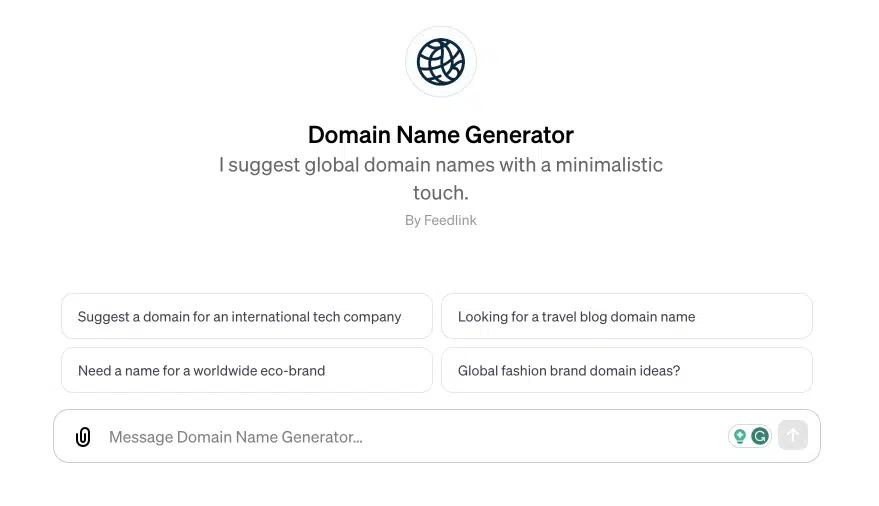
Once you have chosen a domain name, it’s important to register it promptly through a domain registrar like GoDaddy, Namecheap or Feedlink for free .link domains.
Ultimately, you create a lasting and memorable online presence with a domain name that describes your business niche and follows the established rules.
Free domain for 1 year
Claim your .link domain now
Step 3: Design your blog layout
You probably have your main website to present your products and services by this point, and you would think that your blog should reflect the same design.
If you use the same platform for your website and blog, then the design will be reflected on your blog, too. But in case you use an external platform for blogging, such as Tumblr, Medium, or Substack, you should try to use their customization options. In these cases, you adopt colors, fonts, and layouts from your website to the blog, creating a unified and professional experience for your audience.
With a uniform design language across all your portals, you achieve the following:
- Brand recognition – consistent design elements reinforce your brand identity and make it easier for visitors to recognize your content across different platforms;
- Improved user experience – a unified visual style creates a seamless flow between your website and blog, making it easier for users to navigate and find what they need;
- Professionalism – a consistent aesthetic conveys a sense of professionalism and trustworthiness, which can be crucial for building trust with your audience.
In your mission to achieve this seamless design transition, follow these rules:
- Use the same color palette – this ensures consistency across both platforms and reinforces your brand colors;
- Maintain consistent typography – use the same font families and sizes for headings, body text, and other elements;
- Apply the same layout principles – the overall layout of your blog should be consistent with your website, including the navigation bar, logo placement, and footer content;
- Utilize similar visual elements – consider using the same icons, images, and graphics across your website and blog to maintain a cohesive look;
- Adapt your website’s branding – consider adapting your website’s logo, tagline, or other branding elements to create a blog-specific version while maintaining overall consistency.
As an example, check out the design of the Feedkink blogs – As you can see, it uses the same color palette and typography. Plus, the layout remains consistent, and it reuses the same visual elements.
Design customization options
Thankfully, most complete blogging platforms come with a range of design customization tools to achieve your desired aesthetic, such as:
Wix:
- Drag-and-drop interface for easy layout and element placement
- Wide selection of pre-designed blog templates and color options
- Library of customizable fonts and icons
- Advanced features like animation and video integration
Squarespace:
- Intuitive block-based editor for flexible design
- Beautiful and responsive website themes
- Custom CSS and code editing for advanced users
- Integrated image editing tools
WordPress:
- Extensive library of themes and plugins for diverse design options
- A high degree of customization through code editing
- Built-in tools for managing colors, fonts, and layouts
- Third-party plugins for specific design features

Feedlink:
- Several fonts to choose from
- Enhancing your blog posts with images
- Various header customization options
- Author bio feature
- AI blog writing assistant.
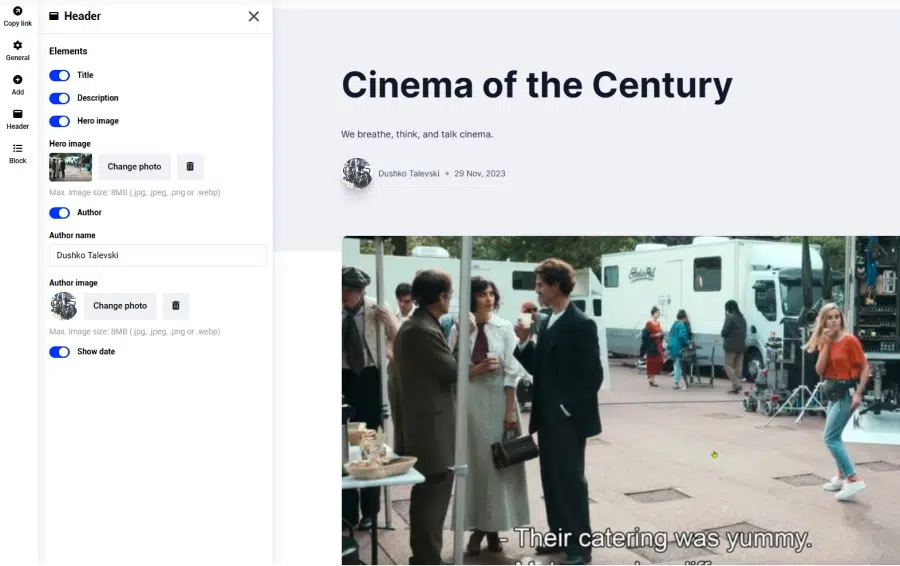
Beginners will love platforms like Feedlink, Wix, Squarespace, and WordPress offer user-friendly interfaces and pre-designed templates to help you get started quickly.
For more advanced users who crave customization, platforms like WordPress, and Webflow offer greater control through code editing and advanced features.
Necessary small business blog pages
Beyond the visuals of your blog, you must also consider adding all the necessary pages and sections that a small business blog needs to have.
These pages serve various purposes, from showcasing your expertise and services to building trust and encouraging conversions.
Without any specific order, you need the following pages:
- Blog homepage – lists your most recent posts separated into categories;
- Resources page – offers the tools visitors need to learn and improve;
- Media & events – publishes the most recent news updates about you;
- Career opportunities – continuously lists open job positions with you;
- About Us – introduces your team, business, mission, and values;
- Services – outlines the services you offer and their benefits;
- Portfolio – showcases your past projects, achievements, and testimonials;
- Contact Us – makes it easy for visitors to get in touch with you;
- FAQ – frequently asked questions and answers about your services;
- Privacy Policy – explains how you collect, use, and protect user data;
- Terms & Conditions – outlines the legal terms and conditions of your website.
While some of these pages will be updated continuously depending on factors such as user preferences and real-time data (blog, career, resource pages, etc.), others remain unchanged, such as the ‘About Us’ page.
Remember, tailor the pages you add per your target audience. Also, you must always ensure they are up-to-date, informative, and visually appealing, not to mention SEO-optimized. You should also consider the content type and impact on performance when adding dynamic content.
Standard blog post layout example
Your individual blog posts should all follow a coherent design language so your visitors know what to expect when they visit any of your posts.
Moreover, you should make your blog posts as easy to consume as possible and help your visitors find the information they need as fast as possible.
To achieve that, follow these guidelines:
- Add an illustrative featured image—the visuals you use must be representative of the main topic you are overviewing;
- A summary of the topic—below the main title, you should add a brief sentence or two covering the text’s main points;
- A table of contents—an extremely important addition that helps readers navigate your blog posts, especially the longer ones;
- Publication & update dates—visitors want and need to know how recent and relevant your blog posts are, and you should tell them that;
- Relevant CTAs—you are running a business after all, so you need to direct your readers to complete an action that will benefit you;
- Real-world examples and stats—readers require proof that what you are saying is true, which can be provided via real examples and facts;
- Various visual components—you need to break your textual components by embedding various images, videos, and recordings;
- Conclusion & FAQs—Last but not least, you should also summarize your blog post and provide answers to common questions related to your topic.
How do all these components look in a real blog? Check out EmbedSocial’s blog post titled “How to Get a Google 5-Star Review Rating” as an example.
Step 4: Brainstorm blog post ideas and create topic clusters
Now that everything works from the technical side and you have designed your blog and all relevant pages, it’s time to start producing great content for your audience!
However, before writing anything, you need to prepare a content strategy based on your business niche. That’s where a topic cluster-based strategy comes in!
What are topic clusters?
Topic clusters are like interconnected constellations of content, each orbiting around a central “pillar page” that delves deeply into your core topics. Around this pillar are smaller, individual blog posts that explore specific subtopics related to the main theme.
They are extremely beneficial for numerous reasons:
- Enhanced SEO – search engines favor websites with well-organized content, and topic clusters demonstrate your expertise and authority on a particular subject;
- Improved user experience – visitors can seamlessly explore related content, navigating from the pillar page to various subtopics that pique their interest, which in turn increases their engagement and offers a deeper understanding of the topic;
- Increased content efficiency – planning content around clusters streamlines your workflow. After all, by defining core themes and relevant subtopics, you can brainstorm and create content efficiently, saving valuable time and effort in the future.
When building your topic clusters, you must first identify your main expertise or interest relevant to your business niche. Then, you can delve deeper into this main topic and research specific subthemes that offer valuable insights or address common questions.
Once you have a grasp on the subtopics, you can begin crafting a comprehensive pillar page that provides an in-depth overview of the main theme. Then, as you write your blog posts in the future, you will embed interlinks in the pillar page leading to them.
Here’s how a cooking blog would organize its content strategy:
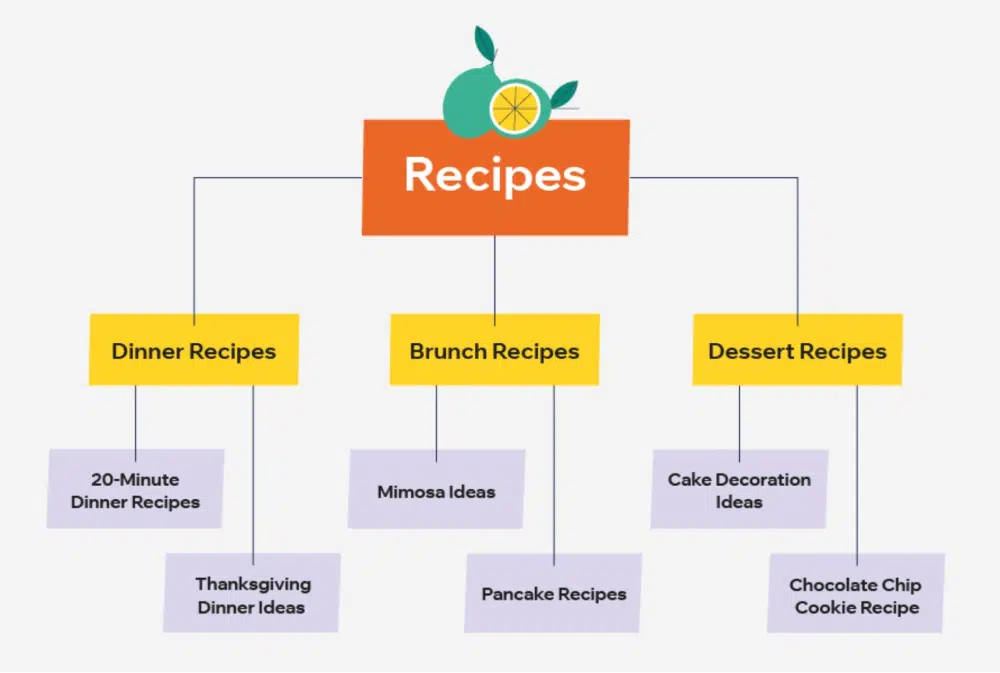
As you can see, this cooking blog’s main niche is recipes, and below it, there are three pillar pages for the different cooking recipes for which they provide content. Then, below them, you can see the individual blog posts they will be writing about.
Brainstorming ideas: Best practices
You can utilize a few tips and tricks when brainstorming your blog post ideas:
- Analyze competitor content – see what topics your competitors are covering and identify potential gaps you can fill with your unique perspective;
- Perform your keyword research – you can also analyze the interest in different topics with tools like Ahrefs and Google Trends, which help you see what people like;
- Consider audience needs and interests – what are your customers’ pain points? What questions do they have? What information would be most valuable to them?
- Leverage industry trends and news – explore current events and trending topics from social media in your niche to create timely and relevant content;
- Repurpose existing content – transform existing materials like presentations, webinars, or white papers into blog posts to maximize your content efforts;
- Engage with your audience – conduct polls or surveys to gather feedback and discover topics they’d like you to explore further.
Remember, the key to thriving with topic clusters lies in consistently creating informative, valuable content that resonates with your audience and consolidates your position as a trusted authority in your business niche. If they view your blog as a reliable source of news, information, and tutorials, they’ll keep flocking to your website as well, thus boosting your conversion rate.
Step 5: Write and edit your compelling blog posts
Crafting engaging blog posts is like shaping a story that resonates with your audience. Here’s how to write and edit compelling content that captures attention:
Write a captivating blog post title + free blog title generator
According to the Google title guidelines for better SEO, your title must be clear and understandable, include relevant keywords, and have a touch of intrigue to entice readers to click.
Titles are most important as they will determine if the reader continues to read the rest of the blog post.
Here are some formulas to create SEO-optimized and clickable titles:
- [Number] + [Adjective] + [Key Topic]: Example: “7 Essential Strategies for Small Business Growth”
- How to [Achieve a Specific Goal] in [Specific Timeframe]: Example: “How to Boost Your Online Sales in 30 Days”
- The Ultimate Guide to [Topic/Process]: Example: “The Ultimate Guide to Efficient Inventory Management”
- [Key Benefit] of [Product/Service]: Example: “The Surprising Benefits of Cloud-Based Accounting Software”
- [Question That Addresses a Common Problem]: Example: “Struggling with Cash Flow? Here’s What You Need to Do”
- Why [Subject/Method] Is Essential for [Target Audience]: Example: “Why Social Media Marketing is Essential for Small Retailers”
- [Do Something] Like a Pro: [Short, Intriguing Phrase]: Example: “Network Like a Pro: Insider Tips for Small Business Owners”
- [Mistake/Myth] and How to [Overcome/Solve It]: Example: “Common Networking Mistakes and How to Avoid Them”
- [Case Study or Success Story] + What We Learned: Example: “How Our Small Business Tripled Its Revenue: Lessons Learned”
- X Reasons Why [Your Product/Service] is [Beneficial Quality]: Example: “5 Reasons Why Our CRM Software is a Game-Changer for Small Businesses”
To generate your blog titles, we’ve created a free AI blog titles generator that is based on the GPT-4 modal.
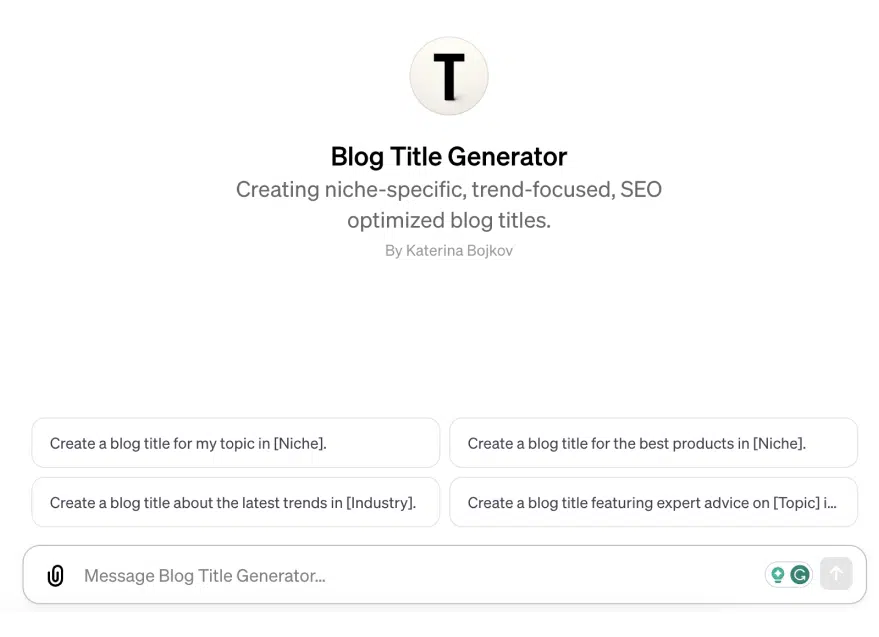
Writing your blog posts
You can ensure high-quality blog content by following several steps:
2. Hook, line, and sinker
Start with a captivating sentence or question that grabs attention and sets the tone. That will make your readers eager to dive deeper into your content.
3. Value-driven content
Focus on providing actionable insights, solving problems, and offering unique perspectives, such as user-generated content from real customers or experts. Remember, your goal is to leave readers informed, inspired, and empowered.
5. Conversational tone
You should often engage your audience using a friendly and relatable writing style. Aim for clarity and avoid overly technical jargon and complex sentences.
5. Structure for readability
Break up your content with clear headings and subheadings, short paragraphs, and bullet points for easy scannability. Rely on white space to create a visually inviting layout.
Here’s what a well-written blog post outline would look like:
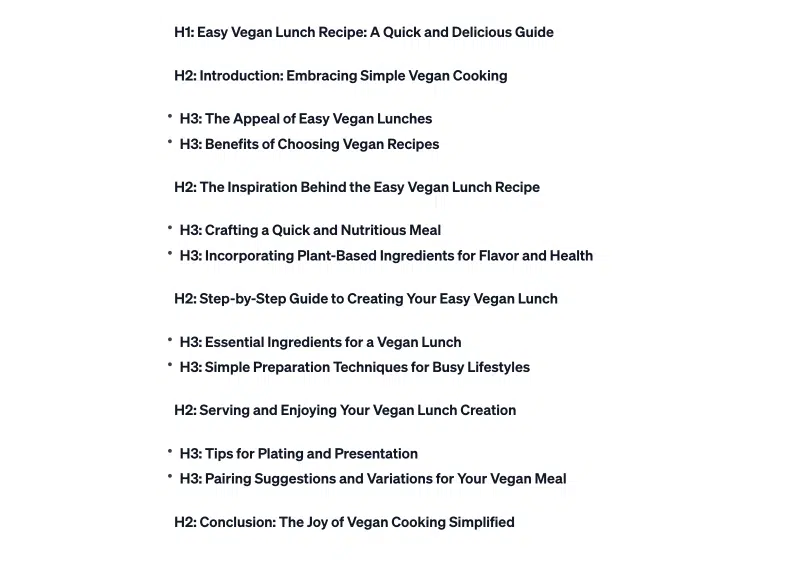
As you can see, your readers must be able to glimpse your post’s structure straight from the table of contents. That way, they’ll manage their expectations when reading it.
Editing your blog posts
After having the bulk of your text ready, let’s polish it to perfection.
1. Take a break and revisit
Don’t immediately publish your draft. You must always practice coming back to it with fresh eyes to identify what you can improve from an objective standpoint.
2. Read aloud for clarity
This simple exercise helps you catch awkward phrasing, grammatical errors, and unclear passages. It ensures your writing flows smoothly and reads naturally.
3. Seek feedback and refine
Ask trusted individuals for constructive criticism. Their insights can help you strengthen your writing, refine your arguments, and ensure your message resonates with your audience.
4. Revise and Polish
Based on your assessment and feedback, revise your content to tighten up the writing, clarify confusing points, and add additional value where needed.
5. Include engaging questions
You can increase your audience engagement by adding follow-up questions below your blog post (or even separate sections), thus prompting responses in the reply section.
Additional tips and tricks
There are a couple of guidelines that you should abide by:
- Enhance your blog visuals – including engaging visuals like images, infographics, and videos to enrich your content and enhance the reading experience;
- Introduce accessibility features – ensure your content is accessible to everyone by using alt text, clear headings, and formatting that follows WCAG guidelines;
- Maintain your brand consistency – maintain your brand voice, logo, and colors throughout your writing and visuals to create a cohesive and recognizable image;
- Utilize writing tools – consider using AI-powered writing assistants like BARD or ChatGPT to streamline the process, but remember to maintain your unique style;
- Optimize for mobile – verify that your posts render flawlessly across all devices, including smartphones and tablets.
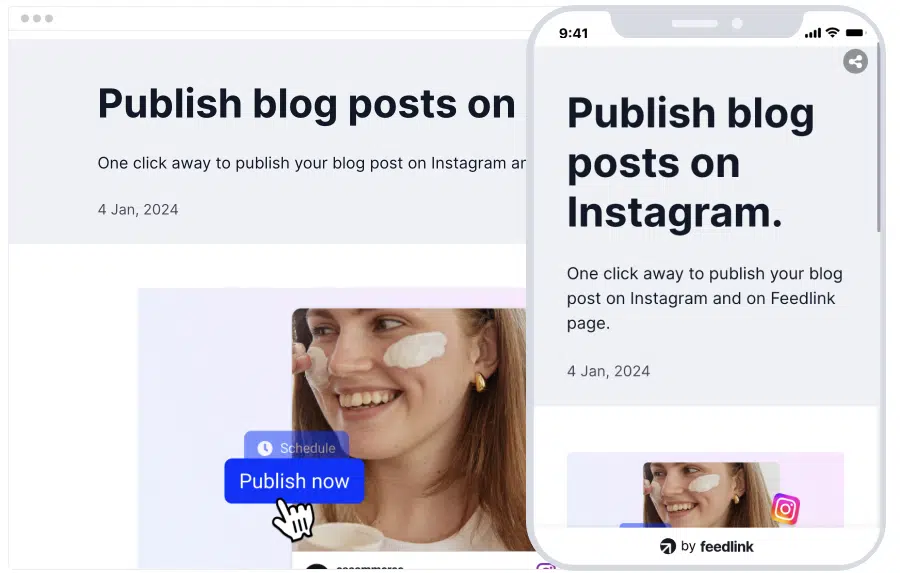
Modern blogging platforms optimize your blog posts for all devices out of the box, so you don’t have to worry about that. For instance, as you can see above, Feedlink automatically adjusts your content for desktop and mobile, and it looks great regardless of your chosen device.
Writing and editing an entire blog post is a skill that can be mastered with time. Ultimately, you must ensure your expertise shines through your style to attract a loyal audience. Remember, the key is to create valuable, informative, and engaging content that consistently delivers value.
Step 6: Use good SEO practices and publish your first blog post
Is your text ready to publish on your blog online? You might think it is, but you must first optimize it to rank higher in search results. Also known as search engine optimization (SEO) practices, these techniques help content rank higher in search pages (SERPs) since organic traffic typically comes from the top results.
Once you get there, you won’t ever have to pay for ads again.
To ensure your effort doesn’t go to waste, follow this checklist:
- Choose the right keywords—identify relevant keywords your target audience uses and weave them naturally throughout your content;
- Structure your text for readability—use clear headings and subheadings to organize your content, enhancing both readability and SEO;
- Provide image descriptions—describe your images with relevant keywords using alt text, improving accessibility and search engine understanding;
- Interlink your blog posts—connect your post to relevant content within your website to keep readers engaged and improve navigation;
- Get external links—consider linking to authoritative sources to add value and credibility to your post, thus building trust with your readers;
- Create some meta magic—craft a compelling meta description (max 160 characters) and a main title (max 60 characters) summarizing your post and enticing clicks.
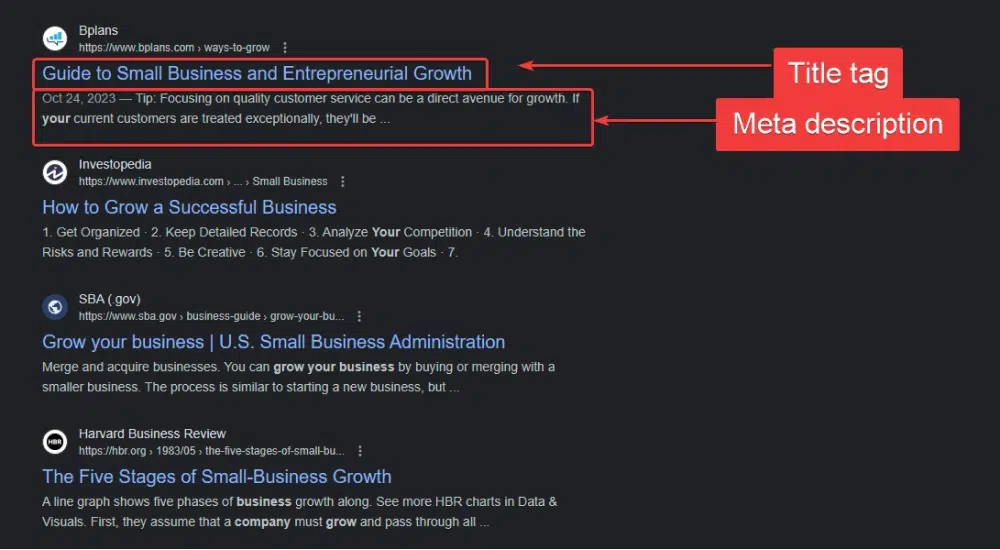
Check out this example of meta tags in action. On top, you can see the main title, which will not be cut off if kept under 60 characters, and beneath, you have a 160-character meta description that summarizes the contents of the page.
Note: Your meta tags should incorporate your main keyword.
Publishing your blog post via Feedlink
Once you finalize the last optimization steps in terms of language and SEO, it’s time to publish your post. This is a process that varies slightly depending on the blogging tool you choose.
For instance, blogging with Feedlink is extremely easy, as it takes just a few clicks:
- Create a new Feedlink account;
- Log into your account and navigate to Posts from the main menu, then click on the top right ‘Create post‘ button and choose ‘Blog post‘;
- Choose a URL slug and copy over the title, description, and blog text;
- Add the required images, customize the post, and tap ‘Publish’;
Once you are done, you can add your blog post to your main Feedlink page. Or you can copy the link from the Link section in the editor and paste it wherever you wish.
Bonus tips:
Implement these additional practices to boost your blog’s performance:
- Get backlinks—encourage other websites to link back to your content, boosting your website’s authority and search ranking;
- Submit to directories—add your post to relevant online directories to increase its visibility and exposure;
- Consider guest posting—contact other similar blogs and websites for guest posting opportunities to reach a wider audience and build backlinks;
- Rely on SEO tools—leverage tools like Google Search Console, SEMrush, and Ahrefs to gain insights and optimize your content for search engines.
Remember, you must refine your approach on an ongoing basis since Google is constantly making minor or major changes to its algorithm. Therefore, if you don’t stay on top of things, your blog’s ranking will go down and become less effective in driving organic traffic.
Step 7: Create an editorial calendar and promote your blog
Completed every step above? Now, it’s time to show off your blog to as many people as possible to get them interested in following it. Also, you’ll need your very own editorial calendar that will help you plan ahead and list upcoming articles. Trust us, it’s a must-have!
You should always plan for at least a month ahead. This consistency will help you churn fresh content regularly. Additionally, your followers will know when you’ll be posting your next gem.
And finally, search engines will love you since they consider your publishing frequency as a ranking factor.
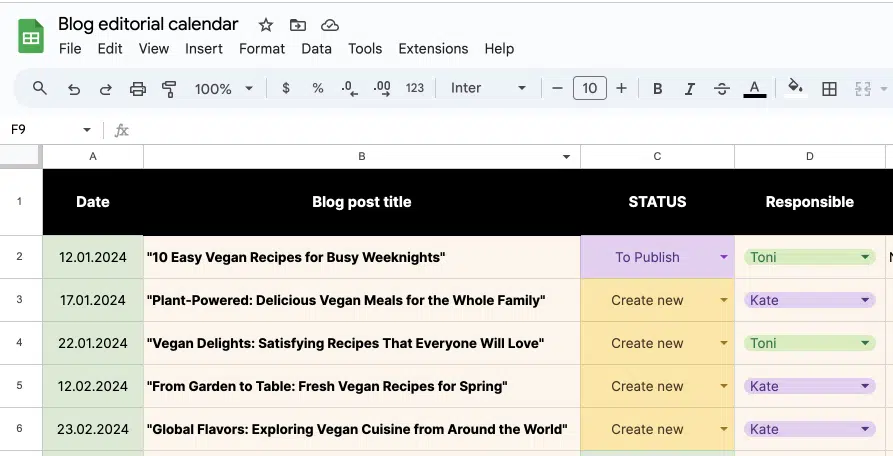
As you can see from this screenshot, the editor in charge has planned to publish one article per week, which ensures consistent content delivery and maintains audience engagement.
You can experiment with different content formats like long-form articles, short listicles, infographics, videos, and podcasts to cater to diverse customers.
However, once your posts go live, remember to track and analyze their performance to determine the type of content that offers the best engagement rates. You can use that data to refine your editorial calendar and optimize your future content strategy.
How to promote your blog once you publish?
The job is not done after publishing your content! You must work hard to promote and grow your blog, and you can do so via several effective methods:
- Mobile-first mindset—ensure your post displays flawlessly across all devices, prioritizing mobile-friendliness;
- Regular strategic scheduling—choose a publishing time that maximizes reach and engagement for your target audience and keep posting regularly;
- Social media synergy—actively share your post across all relevant social media platforms, including Facebook, Twitter, Instagram, and LinkedIn;
- Email marketing magic—promote your posts to your email subscribers via compelling newsletters, thus driving traffic and engagement;
- Collaborations and partnerships: Partner with influencers or other relevant bloggers in your niche for guest posts, cross-promotions, or joint webinars to reach a wider audience;
- Community outreach—participate in online discussions and forums related to your topic, sharing your post and providing valuable insights to attract new readers;
- Paid advertising—consider running targeted ads on social media platforms or search result pages to reach a specific audience and drive traffic to your post;
- Participate in Q&A sites—Quora and Reddit are excellent discussion forums that help enterprises answer relevant questions and follow up on comments. You can create an account and direct users to your blog when they are looking for a certain solution.
In addition to all of the above, remember that word of mouth is still an effective strategy for sharing news. So tell your customers about your blog whenever you get the chance.
What are the costs associated with running a blog?
While there may be a way to run a cost-free blog, you will have to pay certain fees under most circumstances depending on the level of service you need if you want to build a successful blog. We classify them into two main categories: startup costs and ongoing costs:
Startup costs:
- Domain name—registering a domain name is typically around $10-15 per year. Luckily, for the first year, you can claim a free link domain.
- Web host—choosing a web hosting service can range from a few dollars per month to hundreds, depending on your needs and desired features;
- Website design—opting for a professional website design can cost anywhere from a few hundred dollars to several thousand, depending on the customization required;
- Content creation tools—investing in tools like writing software, graphic design tools, or video editing software can range from free to hundreds of dollars per month;
- Marketing and promotion—utilizing social media advertising, paid search engine optimization or influencer collaborations can involve certain costs, too.
Ongoing costs:
- Web hosting and domain name—your web hosting and domain name fees will typically need to be renewed annually or every two years;
- Website security—implementing website security measures like SSL certificates and security plugins can range from free to a few dollars per month;
- Content creation—if you outsource content creation, writing costs can range from $0.02 per word to $1 per word or more, depending on the writer’s experience and expertise;
- Marketing & promotion—maintaining your marketing efforts might require consistent spending on social media ads, influencer partnerships, or SEO tools;
- Email marketing service—if you utilize email marketing, subscription fees for these services can range from a few dollars per month to hundreds of dollars;
- Professional services—depending on your expertise, you might need to hire designers, editors, or programmers for specific tasks, incurring additional costs;
- Paid tools and subscriptions—certain tools and resources like SEO tools, social media management platforms, or stock photo subscriptions might involve fees.
Other cost-affecting factors and cost-saving strategies
Note that your chosen niche can significantly impact costs. Blogs in competitive niches might require more significant marketing investments to stand out. Additionally, creating multimedia content like videos or podcasts can incur additional production costs.
That said, there are certain cost-saving strategies you can implement.
For instance, you can utilize numerous free tools and resources for bloggers, including writing platforms, design templates, and social media scheduling tools. Some platforms even offer a free domain should you choose to keep their ads on your blog.
You can also focus on organic growth via SEO and social media engagement to minimize paid advertising costs. Why not learn new skills, too? Investing time in learning essential skills like writing, editing, and basic design can reduce reliance on paid services.
Last but not least, remember to collaborate and network. Partnering with other bloggers for cross-promotion can significantly reduce individual marketing expenses.
At the end of the day, while running a blog undoubtedly involves costs, the key is to be strategic, invest in the right areas, and adapt your approach as your blog grows. By carefully planning your budget, prioritizing cost-saving strategies, and focusing on creating high-quality content, you can manage your blog’s expenses effectively and achieve your blogging goals.
Key takeaways: Launching your blog and beyond
By now, you should be equipped with the knowledge and resources necessary to launch your small business blog and embark on a successful journey. Keep in mind that success doesn’t happen overnight—it requires dedication, consistency, and a willingness to learn and adapt.
As you delve deeper into the world of blogging, remember these key takeaways:
- Provide value—always strive to create content that offers genuine value to your audience. Whether it’s informative, engaging, or entertaining, ensure your content solves problems, answers questions, and offers a unique perspective;
- Build relationships—blogging is about connecting with your audience. Interact with your readers, answer their questions, and actively engage in conversations. Building genuine relationships fosters trust and loyalty, leading to long-term success;
- Stay consistent—consistency is key. Develop a content calendar, set realistic goals, and publish regularly to keep your audience engaged and coming back for more;
- Learn & adapt—the blogging landscape is constantly evolving. Stay informed about industry trends, learn new skills, and adapt your strategy to maintain relevance;
- Track & analyze—data is your friend. Monitor your blog’s performance, track key metrics, and analyze what resonates with your audience. Use your insights to refine your content strategy and optimize for growth;
- Be patient—building a successful blog takes time and effort. Don’t get discouraged by slow progress. Stay focused and keep creating valuable content.
Blogging is a powerful tool for small businesses. By following these steps and embracing the ongoing learning process, you can leverage your blog to achieve your business goals, connect with your audience, and establish yourself as a thought leader in your niche.
Now, go forth and share your voice with the world!
Free blogging tool
Start a free blog
FAQs
What exactly does blogging mean?
Blogging is creating and publishing content on a blog site, which acts as an online journal or informational website. The process includes writing articles, also known as blog posts, which can cover a wide range of topics and are often written in an informal or conversational style. While used by individuals, businesses also rely on blogging to share their expertise, provide professional insights and educational content, and connect with their customers.
How do I start a blog from scratch?
Starting a blog is exciting! You just need to choose a catchy name that describes your business or personal dealings, then pick a user-friendly option like the WordPress blogging platform or Wix. Finally, you need to sign up for hosting (if required), customize your blog, and start posting!
How can I start a blog for free?
Most popular complete blogging platforms like Feedlink, Wix, Weebly, and WordPress blog also include a free tier subscription with certain limitations. That said, you can still set up your blog to write up and publish your blog posts with significant savings.
What makes a successful blog?
All successful blogs combine engaging, well-researched content with a clear, audience-focused approach. They aim to deliver value to their readers, whether through informative articles, entertaining stories, or practical advice. Finally, they incorporate strong SEO practices, visually appealing design, and regular updates to build and maintain a loyal reader base.
How does Google AdSense work?
Bloggers can place Google AdSense ads on their blogs to generate income. Google matches ads to your blog content and reader interests, thus increasing traffic and engagement. All of that makes AdSense a powerful tool for monetization and brand building.

